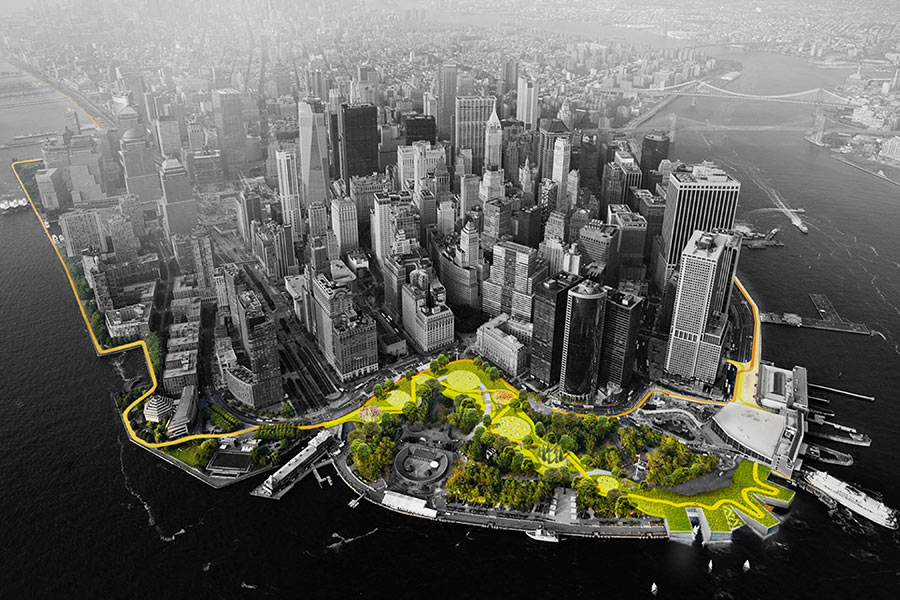
In April, when the 10 finalists in the Department of Housing and Urban Development’s Rebuild By Design competition presented their plans for a more resilient Northeast, the underlying question behind the initiative was: What’s Next? What—if anything—would actually come out of Rebuild By Design? Today, that question was answered.
At the Jacob Riis Houses, New York City Mayor Bill de Blasio, Senator Chuck Schumer, Governor Andrew Cuomo, HUD Secretary Shaun Donovan, and Zia Khan of the Rockefeller Foundation announced that hundreds of millions of dollars are in place to implement BIG’s berm for Lower Manhattan, Scape’s living breakwaters off Staten Island, Penn Design/OLIN’s resiliency upgrades for the South Bronx, and Interboro’s strategies to protect Nassau County.
Later in the day, in Little Field, New Jersey, Secretary Donovan and Governor Chris Christie revealed that MIT’s plans for new parkland in the Meadowlands and OMA’s comprehensive flood protection system for Hoboken would also receive federal funds.
These six winning teams are out of an initial 148 who entered the competition last summer.
|
BIG’s plan protects Manhattan with A LANDSCAPED BERM. See more of their proposal here.
Courtesy BIG
|
||
“Implementing these proposals is morally the right thing to do because they will save lives,” said Secretary Donovan at the day’s first announcement. “But it also makes economic sense because for every dollar that we spend today on hazard mitigation, we save at least four dollars the next time disaster strikes.”
While the design and implementation specifics of each plan have not been finalized, the investment in these proposals is significant: $355 million for New York City, $185 million for New York State, and $380 million for New Jersey. The money comes out of HUD’s Community Development Block Grant program and is in addition to the billions of dollars already being spent on resiliency projects led by the Army Corps of Engineers and FEMA.
|
A team headed by OLIN and PennDesign called for "INTEGRATED STORM PROTECTION AND GREEN INFRASTRUCTURE). See more of the proposal here.
Courtesy OLIN/PENN DESIGN
|
||
At the announcement, Mayor de Blasio said that within the next four or five years, New Yorkers are going to see “a hugely different physical reality in this city.” And that is because these plans do more than protect against the water, they reimagine and reopen the city’s connection to it.
|
A key component of SCAPE’s proposal was LIVING BREAKWATERS. See more of the proposal here.
Courtesy SCAPE
|
||
About 95 percent of New York City’s money goes toward realizing a section of BIG’s “Big U” proposal to wrap Lower Manhattan in a berm and green space. The new “bridging berm” along the Lower East Side will provide waterfront space for the neighborhood and protect 29,000 public housing units from the next storm. The city will also receive $20 million for continued study and planning as part of PennDesign/OLIN’s proposal for Hunts Point in the South Bronx, which is a regional hub for food distribution.
|
Interboro’s proposal called for green-blue corridors See more of the proposal here.
Courtesy Interboro
|
||
For New York State, $125 million will help fund Interboro’s proposal for Nassau County, which transforms the Mill River into a blue-green corridor. And another $60 million is set for SCAPE’s oyster reefs—or “living breakwaters”—to protect Staten Island’s South Shore.
|
OMA’s team proposed strategy for hoboken resiliency. See more of their proposal here.
Courtesy OMA
|
||
In New Jersey, Hoboken will receive $230 million for OMA’s plan to flood-proof the city with a mix of hard and soft infrastructure. There is also $150 million set for the “New Meadowlands”—a public park designed by MIT’s Center for Advanced Urbanism.
Secretary Donovan said that the winning projects were chosen not just for their feasibility, but because they could best serve as models of resiliency for other vulnerable parts other country.
The Full List of Participants:
Team BIG: One Architecture, Starr Whitehouse, James Lima Planning + Development, Project Projects, Green Shield Ecology, AEA Consulting, Level Agency for Infrastructure, Arcadis, and the Parsons School of Constructed Environments.
Team Interboro: Apex, Bosch Slabbers, Center for Urban Pedagogy, David Rusk, Deltars, H+N+S Landscape Architects, IMG Rebel, NJIT Infrastructure Planning Program, Palmbout Urban Landscapes, Project Projects, and TU Delft.
Team OMA: Royal HaskoningDHV; Balmori Associates; and HR&A Advisors.
Team MIT CAU: ZUS + URBANISTEN with Deltares; 75B; and Volker Infra Design.
Team PennDesign/OLIN: R&A Advisors, eDesign Dynamics, Level Infrastructure, Barretto Bay Strategies, McLaren Engineering Group, Philip Habib & Associates, Buro Happold.
Team SCAPE: Parsons Brinckerhoff, Dr. Philip Orton / Stevens Institute of Technology, Ocean & Coastal Consultants, SeArc Ecological Consulting, LOT-EK, MTWTF, The Harbor School and Paul Greenberg.